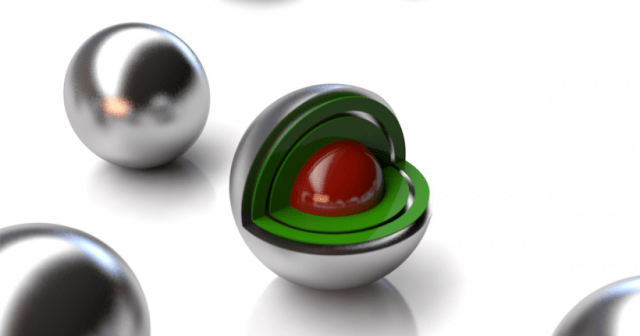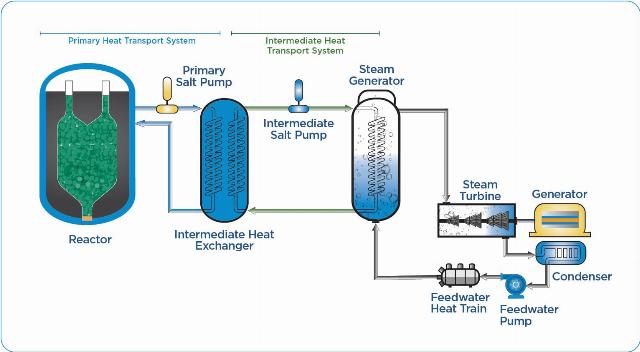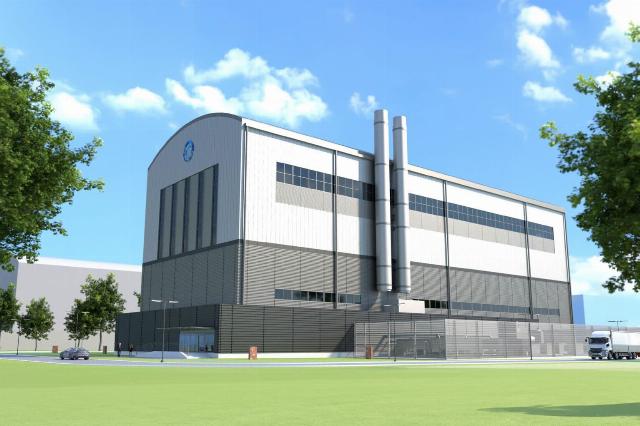The Hermes project became the first non-water reactor in the United States in half a century. It is distinguished from liquid salt reactors in other countries by an unusual scheme using salt only to cool the reactor, and not as a solvent for nuclear fuel in the core.
In the 1960s, the first experimental liquid salt reactors were built in the USA. The nuclear fuel there was dissolved in salt with the general formula FLiBe . This solution made it possible to remove part of the fuel ("spent") and add a new one instead right during the operation of the reactor, without stopping it to overload the fuel.
In addition, the salt was easily heated to plus 700 degrees Celsius, which allowed for high efficiency (30-40% higher than in the then water-water reactors). The salt was brought to high temperatures at a pressure of about one atmosphere, and not at 150-200, as in water-water reactors. Therefore, the reactor shell was not made thick, like battleship armor (and like conventional modern reactors), but only a few centimeters thick.
However, those reactors also had big drawbacks: salt with nuclear fuel had high corrosion activity. When used for heat transfer outside the primary circuit, induced radioactivity was created in pipelines and heat exchangers. A large amount of tritium was also released (from the lithium component of the salt), which also created corrosion and radiation problems for the structural elements of the reactor.
Now the American company Kairos Power has begun construction of a low-power demonstration reactor "Hermes", in which the liquid salt concept has been seriously changed . The nuclear fuel will not be dissolved in salt, but packed in TRISO balls, in which the fuel (uranium oxide) is enclosed in a shell of pyrolytic graphite coated with silicon carbide, on top of which another layer of pyrolytic graphite is applied.

A model of a single TRISO ball in a section. Uranium oxide is shown in red in the center. The ball is much more resistant to heat than conventional metal rods of fuel rods, which is a plus, but the presence of carbon in it excludes the use of fast neutrons, which is a minus
Image source: Kairos Power
The nuclear reaction there is triggered by the deceleration of thermal neutrons by graphite, that is, it is a slow neutron reactor. On the one hand, this is a minus, since previously liquid salt reactors were powered by fast neutrons — they could work as breeder reactors producing fissile plutonium from non-fissile uranium-238.
But in theory, the new design has its advantages. The FLiBe salt surrounding the steel container with TRISO balls does not contain nuclear fuel, therefore it is non-radioactive. Due to the resulting lower neutron load, less tellurium will be produced in it (it led to cracking of steel surfaces in early liquid salt reactors).
After the reactor, the salt goes to the heat exchanger, where it heats the intermediate salt based on certain (polluted) nitrates. Already melted nitrates will heat the water for steam generators to at least plus 585 degrees. Together with the presence of superheating, this, in theory, should raise the efficiency of such reactors to 45%. For comparison, typical water-to-water reactors have an efficiency of no more than 35%, and sodium reactors have a maximum of 40%.

TRISO balls will be poured into the reactor (on the left) as it works (the area with them is shown in green), and they will be gradually removed from below (all this without stopping work). The container with the balls is surrounded by molten salt based on fluorine, lithium and beryllium. It is fed into an intermediate heat exchanger, where it circulates through the tubes. The main volume of the heat exchanger is filled with a second salt of a different composition. From there, the salt of the second type goes to the steam generator, where it heats the water to steam at a pressure of 190 atmospheres. In fact, the new reactor is three-circuit
Image source: Kairos Power
The Hermes under construction will enter service in 2027. It will not generate electricity, since the reactor is a demonstration one — it will only be able to generate heat. So the developers want to test how resistant the new approach to liquid salt reactors is to corrosion and other similar reactor problems. If all goes well, in the early 2030s Kairos Power plans to mass-build modular reactors of the Hermes type with 145 megawatts of electric power.
The company's own investments in the project will amount to $ 100 million. Another 300 million will be added by the US Department of Energy. Many in the States criticized this project, pointing out that it, in fact, does not have many advantages. It will not be possible to burn minor actinides (the most difficult component of nuclear fuel to eliminate) in it, since TRISO are not strong in using such fuel. Due to the use of slow neutrons, a breeder reactor will not work either - slow neutrons weakly convert non-fissile uranium-238 into fissile plutonium.
As a result, of the advantages of a liquid salt reactor, only the high core temperature and the increased efficiency due to this remain. Against the background of potential difficulties with corrosion due to aggressive salts, this does not look like a risk-free investment.
On the other hand, if the corrosion problems are solved, such reactors can become cheaper than water-based ones due to a much lighter and simpler reactor vessel and the overall smaller dimensions of such nuclear power plants.

